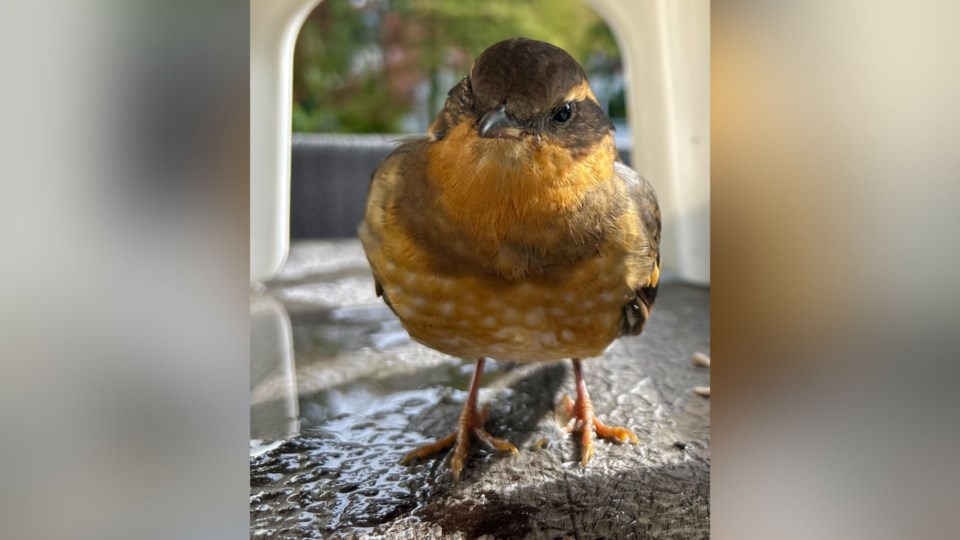It is a thud no one wants to hear, that moment when a bird hits a window.
It happened recently to Marie-Ève Boutin and her family when a varied thrush hit the patio door at very high speed.
"After falling to the ground, she was moving her head around in confusion and could not stand up. Her right eye seemed injured as well," Boutin recalled in an email to The Squamish Chief.
"We put her in a shallow basket to allow her to rest, hoping she would recover as they sometimes do. It took her three and a half hours to finally stand up and hop out of the basket."
Boutin next reached out to the nearest bird rescue in Burnaby at the Wildlife Rescue Centre.
Jackie McQuillan, support centre manager with the Wildlife Rescue Association of BC, said that, especially in winter, the centre sees a lot of varied thrushes that have hit windows.
"That seems to be the thing that troubles them most in urban areas," she said.
"If we get a snowy day, that is very bright so lots of sunshine, we'll often see them hit windows at record rates."
She said some of the varied thrushes are migrating at this time of year, so increasing the number of birds moving through.
"Sometimes, it's the double whammy where they hit the window first, and then a cat has picked them up because they are quite compromised after they've hit something."
Varied thrush are common in our region and all the way up to Alaska. According to McQuillan, those in our region are here year-round, but those from the northernmost range will move south during winter.
"They're really beautiful birds. We often see them ... on those cold, snowy days, and they're sensitive; they like very specific kind of dark, wet forests. So that's usually where we see them."
She said it is best to do as Boutin did and take an injured bird to the rescue centre as soon as possible.
But first, as soon as you see the unfortunate bird, prepare what you will need for a safe rescue. You will need a small towel, shoebox or container with a lid. Place a small cloth at the bottom of the box so the bird doesn't slide around inside.
Punch breathing holes in the box.
Next, you are ready to pick up the bird.
"You want to go out and slowly approach the bird and throw gently the towel over top of it so that its full body is covered, including the head, then you can take the bird up, gently place it in the box; we want you to remove the towel so that it's not staying covered in the box by the towel,” she explained.
Then secure the lid.
Contrary to what folks might want to do, do not give the bird food or water.
McQuillan said much like when humans are in a traumatic car accident, injured birds are not going to be thinking of water or a snack right after hitting a window.
"The second thing that often happens is if you've got food and water in the container, during transport, it often gets spilled, or if the animal is struggling around, it will get spilled. And if they get water all over them, then they often end up feeling quite cold, or they get the food spilled all over them and that can get all over their feathers. So during that initial time, if you're going to be able to get them to us quite quickly, usually the best is just no food or water," she said.
If it isn't possible to quickly transport the bird to the centre, give them a call, and staff can help Squamish folks out with guidance and resources, McQuillan noted.
With appropriate care at the centre, they can survive, though not all do.
Unfortunately, the bird Boutin found didn't make it
"Turns out she also had a broken shoulder that could not be repaired," Boutin said. "I was truly hoping she would recover."
Stop bird strikes
The best thing, of course, is if the birds don't hit the windows at all.
McQuillan encourages locals to take steps to mitigate that risk for birds.
Because a lot of birds migrate at night, turning off interior lights when able is helpful because light in the dark attracts them towards the window.
For the daytime, she suggests putting stickers on the windows that prevent the birds from accidentally flying into them; one such product is called Feather Friendly.
The Squamish Environment Society (SES) has done work, installing bird strike deterrents on glass panels and railings along the Mamquam Blind Channel. (Find out more on the SES website.)
It is something Boutin has taken to heart and hopes others in town do too.
"Of course, it's nice to enjoy an uninterrupted view in such an incredible town as Squamish, but as an act of caring, think about painting sheer dots or placing sheer decals as one way to help birds see your windows," said Boutin.
"At our house, we have three culprit windows, so they will be the ones to be modified very soon. For those with glass railings—and there are a lot of them, especially in new developments—you can apply the same tricks."



